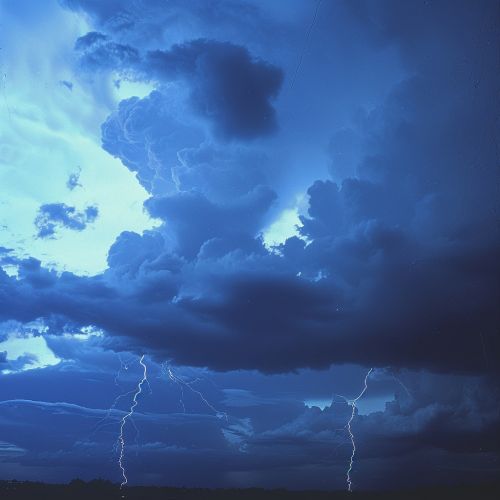Severe weather: Difference between revisions
(Created page with "== Introduction == Severe weather refers to any dangerous meteorological phenomena with the potential to cause damage, serious social disruption, or loss of human life. Types of severe weather phenomena include blizzards, thunderstorms, hurricanes, tornadoes, and heatwaves. Such events are factors in the weather severity of different regions. == Understanding Severe Weather == Severe weather occurs fro...") |
No edit summary |
||
| Line 7: | Line 7: | ||
== Types of Severe Weather == | == Types of Severe Weather == | ||
=== Thunderstorms === | === Thunderstorms === | ||
[[Image:Detail-78811.jpg|thumb|center|A thunderstorm with dark clouds and lightning strikes.]] | |||
Thunderstorms are a type of severe weather characterized by the presence of lightning and its acoustic effect on the Earth's atmosphere, known as thunder. They are usually accompanied by strong winds, heavy rain, and sometimes snow, sleet, hail, or, in contrast, no precipitation at all. | Thunderstorms are a type of severe weather characterized by the presence of lightning and its acoustic effect on the Earth's atmosphere, known as thunder. They are usually accompanied by strong winds, heavy rain, and sometimes snow, sleet, hail, or, in contrast, no precipitation at all. | ||
Revision as of 18:09, 15 May 2024
Introduction
Severe weather refers to any dangerous meteorological phenomena with the potential to cause damage, serious social disruption, or loss of human life. Types of severe weather phenomena include blizzards, thunderstorms, hurricanes, tornadoes, and heatwaves. Such events are factors in the weather severity of different regions.
Understanding Severe Weather
Severe weather occurs from a variety of conditions, often formed through complex atmospheric interactions. These interactions can result in significant physical effects, such as intense wind, precipitation, and lightning. Understanding these phenomena involves a combination of meteorological observations and predictive modeling.
Types of Severe Weather
Thunderstorms

Thunderstorms are a type of severe weather characterized by the presence of lightning and its acoustic effect on the Earth's atmosphere, known as thunder. They are usually accompanied by strong winds, heavy rain, and sometimes snow, sleet, hail, or, in contrast, no precipitation at all.
Tornadoes
Tornadoes are a violent and dangerous type of severe weather. They are characterized by a funnel-shaped cloud that is in contact with both the surface of the Earth and a cumulonimbus cloud or, in rare cases, the base of a cumulus cloud.
Hurricanes
Hurricanes are a type of severe weather characterized by a large, swirling low-pressure system that forms over warm ocean waters. The swirling air rises and cools, creating clouds and thunderstorms.
Heatwaves
Heatwaves are a type of severe weather characterized by prolonged periods of excessively hot weather, which may be accompanied by high humidity.
Blizzards
Blizzards are a severe snowstorm with strong sustained winds of at least 35 mph (56 km/h) and lasting for a prolonged period of time—typically three hours or more.
Impacts of Severe Weather
Severe weather can cause significant damage to human-made structures, as well as to natural environments. Damage from severe weather events can result in billions of dollars in damage and loss of life.
Predicting Severe Weather
Meteorologists use a variety of tools and techniques to predict severe weather, including Doppler radar, weather satellites, and weather models. Despite advances in technology, predicting the timing and severity of severe weather remains a challenge.
Mitigation and Preparedness
Communities, individuals, and governments can take steps to mitigate the impacts of severe weather through preparedness measures, such as developing emergency plans, improving infrastructure, and implementing warning systems.
